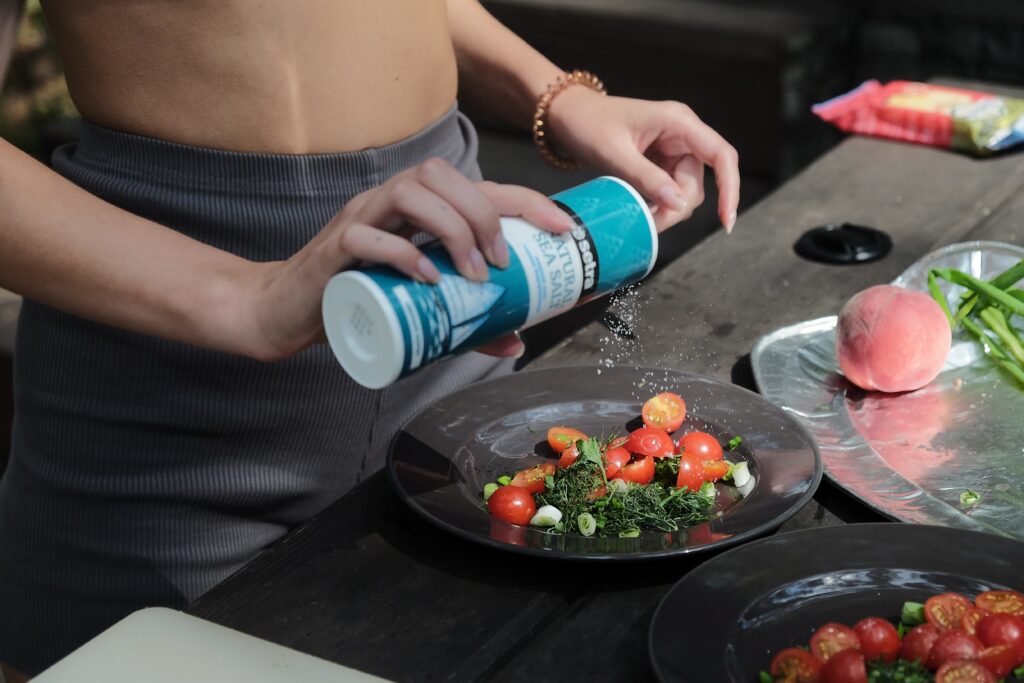Some of the links on this page are affiliate links, which means that Buzzy Kitchen earns commission from purchases made – at absolutely no extra cost to you. Thank you so much for supporting Buzzy Kitchen!
You probably wouldn’t notice the difference between sea salt and table salt as you cook with them, or sprinkle them on your food.
If you were to put the two types of salt side-by-side, however, the first difference would likely be blindingly obvious: sea salt has larger grains or flakes, similar to tiny rocks or crystals; table salt has smaller grains/flakes and a consistency similar to sugar.
For the other differences, however, we need to take a closer look.
What is Sea Salt?
Other names: salt, solar salt, bay salt.
Sea salt, as the name probably suggests, comes from the sea. It is produced when seawater evaporates, leaving salt deposits left over.
These days, sea salt doesn’t actually have to come from the sea in order to be given the name. In fact, the American Food and Drug Administration (FDA) will allow a salt to be called ‘sea salt’ provided it meets certain requirements and restrictions in terms of purity.
Because sea salt is less refined than table salt, there are other trace elements and minerals that have been infused directly from the sea. These include sulphur, silicon, potassium, calcium, iron, magnesium, and iodine.
What is Table Salt?
Other names: salt, regular salt, refined salt, iodised/iodized salt.
Table salt is produced in a different way to sea salt (usually). Rather than being created and then mined when seawater evaporates, table salt is mined from deposits deep underground. Additives are often added to the salt, which are used to counteract common geographical health problems, such as deficiencies in iodine.

Image by Bruno /Germany from Pixabay
Because of the differences in creation, table salt tends to contain fewer trace elements (minerals and vitamins) than sea salt, which is why iodine and other elements are added.
What is the Difference between Sea Salt and Table Salt?
There are actually quite a few differences between table salt and sea salt, when you get into the literal nitty-gritty of it.
Grain Size
Table salt is granulated, whereas sea salt is less refined and processed. Because of this, table salt tends to come in a very fine form, just like sugar.
Sea salt usually comes in slightly larger rocks or crystals, but you can also get fine-grain varieties to add to salt shakers and similar.

Photo by @fmdevice / Unsplash
Colour
Because of the differences in creation, table salt and sea salt tend to look a little different when it comes to colour. Table salt has a grey-ish tinge to it. Sea salt can be quite colourful because of the trace elements the grains retain from the water, and because the salt is less refined and processed.
Texture
Because sea salt usually has large, coarser grains or flakes than table salt, sea salt will add an extra crunchiness to a dish that you sprinkle it on.
Table salt tends to be used to flavour or season food rather than adding texture, although it will still have a certain crunchiness, similar to granulated sugar.
Taste
In some cases, sea salt can be saltier than table salt, but this is dependent on where in the world it is mined from, as well as other factors.
Can I Substitute Table Salt for Sea Salt?
You can substitute table salt for sea salt – and vice versa – in most cases. You will need to take a couple of things into consideration before you do, however.
To start with, a teaspoon of table salt is going to be saltier than a teaspoon of sea salt, unless the grains/flakes of sea salt are refined until they are the same size as table salt.

Photo by Bru-nO / Pixabay
You can fit more grains of salt on a spoon than you can grains of rough, unprocessed sea salt. Because there is more salt, the dish will be saltier.
You will usually need more sea salt than table salt to get the same salty effect, but this is only when you get up to the larger amounts.
Generally, if you’re substituting pinch-for-pinch, you will not need to increase or reduce the amount of salt you use by much, if at all.
Which is Better for You: Sea Salt or Table Salt?
Although it is believed that sea salt is better for you than table salt, that is not really the case. As far as nutritional value goes, they are on par with each other, according to Web MD and other medical-based sources.
In terms of sodium, sea salt and table salt offer the same amount, although you will find more trace elements in sea salt than you will in table salt, because of the refinement process.

Photo by mkupiec7 / Pixabay
Table salt, these days, is fortified with other minerals and vitamins, such as iodine, to deal with geographical health issues. The amounts, and which specific ones are added, are determined by the geographical area.
For example, in the UK, the iodine content of iodized salt must be 10-22 ppm.
In the USA, on the other hand, the iodine content of iodized salt must be 46-77 ppm.
Tuscanini Coarse Mediterranean Sea Salt (From Sicily)
£6.99 / 454g on Amazon – Certified Kosher – All Natural – Cooking – Seasoning – Suitable for Salt Baths
Saxa Table Salt
£1.05 / 750g at Tesco – Cooking – Seasoning
